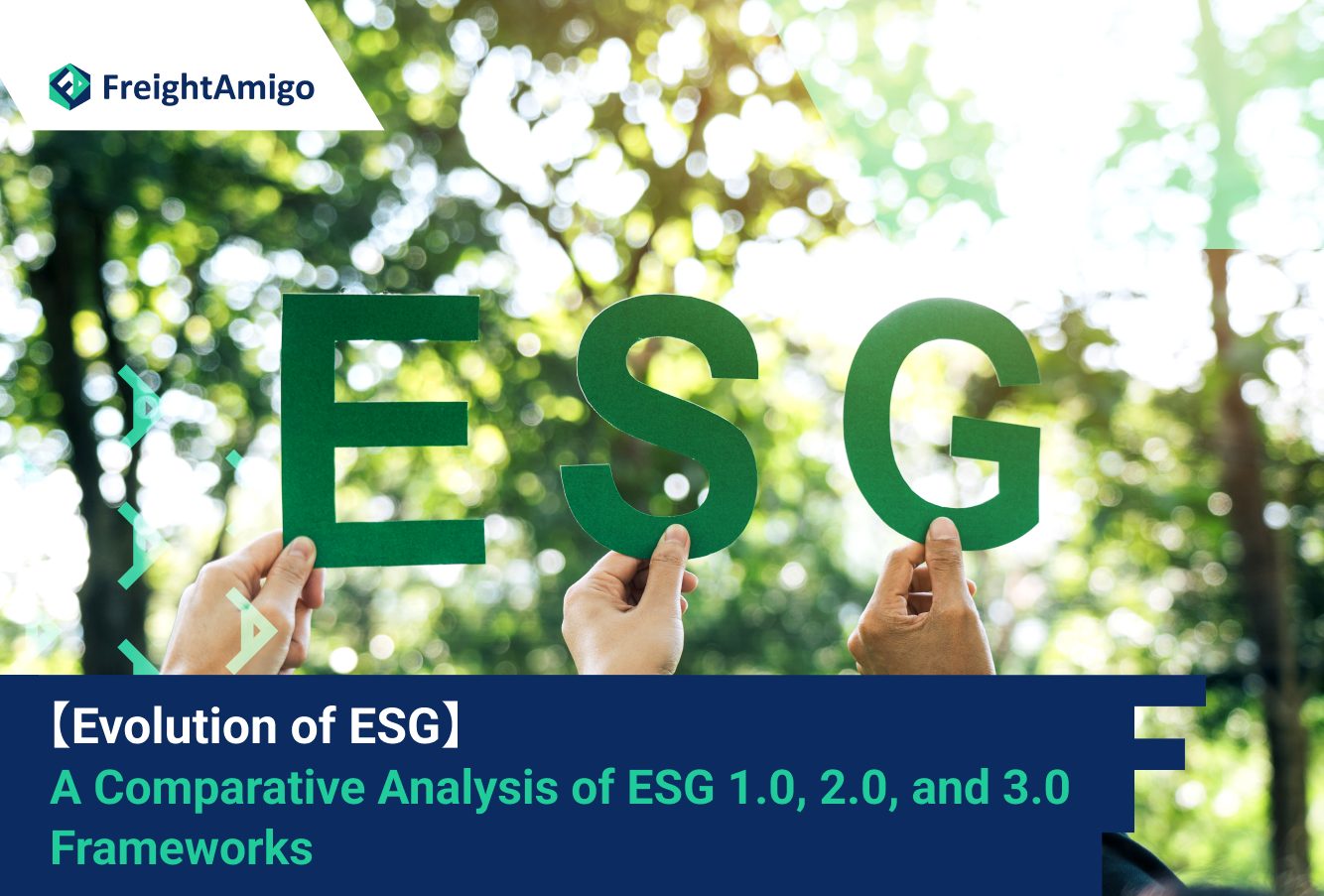Author Name: Tiffany Lee – Marketing Analyst at FreightAmigo
ESG, which stands for environmental, social, and governance, has evolved significantly over the years. From its inception as ESG 1.0, which focused on exclusions based on moral grounds, to the more sophisticated and comprehensive ESG 3.0, the landscape of ESG has transformed. In this article, we will explore the evolution of ESG and examine the key features and advancements of each framework.
Want To Compare The Best Express, Air Freight, Sea Freight, Rail Freight & Trucking Rates So As To Have Better Control On Cost?
ESG 1.0: The Origins of Exclusions
ESG 1.0 emerged when religious institutions started excluding companies based on moral principles. During this phase, the primary focus was on avoiding association with industries that compromised certain values. Exclusions were made without considering the financial implications of ESG factors. While this approach served as a starting point, it lacked a comprehensive understanding of the potential impact of ESG on investment performance.
ESG 2.0: The Rise of Risk Management
ESG 2.0 marked a shift towards recognizing the material financial implications of ESG factors. Companies started appointing “heads of ESG” to address the growing demands for ESG-related information. However, these ESG heads were often mid-level executives with functional backgrounds, lacking specific expertise in ESG. The focus was primarily on risk management and satisfying internal and external inquiries.
The Governance Dimension
One crucial aspect of ESG 2.0 was the focus on corporate governance. Corporate governance refers to the system of rules, practices, and processes that influence how a company is directed and controlled. It encompasses the balance of interests among stakeholders, including investors, employees, customers, and communities.
During this phase, the analysis of corporate governance aimed to assess how a company’s governance practices could impact its credit profile. Factors such as ownership and board effectiveness, management culture and internal controls, transparency and reporting, and regulatory, tax, and legal frameworks were evaluated. Companies with independent and diverse boards, effective control systems, and transparent communication were seen as mitigating credit risks.
Credit Assessment Scorecards
To systematically assess credit risk, proprietary Credit Assessment Scorecards were introduced. These scorecards provided a structured framework for evaluating credit risk, generating credit scores that aligned with credit ratings. The governance dimension was included in these scorecards as part of the broader management and governance (M&G) assessment. The assessment of M&G acted as a modifier to the credit assessment, taking into account the company’s governance practices and their potential impact on credit risk.
ESG 3.0: Capitalizing on Impact and Value Creation
ESG 3.0 represents the current phase of ESG evolution, characterized by a focus on impact and value creation. Companies are no longer satisfied with merely managing risk; they are actively seeking opportunities to generate positive impact through their ESG practices. ESG is now viewed as a commercial imperative rather than just a functional requirement.
ESG 3.0 Metrics
ESG 3.0 introduces new metrics to measure the potential impact of ESG practices. One such metric is Potential Avoided Emissions (PAE), which quantifies the emissions prevented by an existing solution compared to the most likely business-as-usual alternative. PAE provides a forward-looking and quantitative assessment of a company’s contribution to reducing carbon emissions. Time Value of Carbon is another important concept in ESG 3.0, recognizing the greater value of emissions prevented today compared to those prevented in the future. Companies that prioritize investments in commercially viable technologies with high PAE impact are more likely to be viewed favorably in ESG assessments.
Next-Generation ESG Leaders
ESG 3.0 requires a new breed of ESG leaders who possess a combination of ESG expertise and business acumen. These leaders are often senior executives with cross-functional backgrounds, bringing diverse perspectives to their roles. They are responsible for creating best-in-class ESG policies and frameworks, integrating ESG across the organization, and serving as the public face of the company’s ESG initiatives. ESG leaders must also engage with external partners to promote sustainability in their broader ecosystem.
The Role of Data and Reporting
Data plays a critical role in driving the evolution of ESG frameworks. Organizations are increasingly expected to disclose their ESG practices and performance. The Securities and Exchange Commission (SEC) has proposed mandatory climate-related disclosures, which would require companies to report on the risks they face from climate change and the transition to a low-carbon economy. This regulatory push for transparency and reporting underscores the growing importance of ESG data in decision-making and stakeholder engagement.
Conclusion
ESG has come a long way from its origins as a moral exclusion strategy. The evolution of ESG frameworks, from 1.0 to 2.0 and now 3.0, reflects the growing recognition of the financial implications and value creation potential of ESG factors. Companies are embracing ESG as a commercial imperative and seeking opportunities to generate positive impact. The role of ESG leaders is expanding, requiring individuals with expertise in both ESG and business strategy. As the demand for ESG data and reporting continues to grow, organizations must adapt and incorporate ESG practices into their core operations to thrive in the evolving landscape of sustainable investing.
There Are Different Options For Cargo Transportation. If You Want To Choose The Most Convenient And Suitable Solution, It Is Best To Have The Full Support Of Logistics Experts! If You Are Planning To Ship Goods Overseas, Please Go To The FreightAmigo Page For Inquiries.
===
Read More:
【Cosmetic Product Recycling】 A Guide to Sustainable Reverse Logistics
【Rise of Green Supply Chain】 Pioneering Sustainable Practices in Logistics
【ESG in Logistics】 How ESG Practices Drive Social Responsibility in Logistics
===
If you have any inquiries on logistics/supply chain, feel free to contact FreightAmigo now:
Chat with us online OR
Phone : +852 28121686
WhatsApp: +852 27467829









































